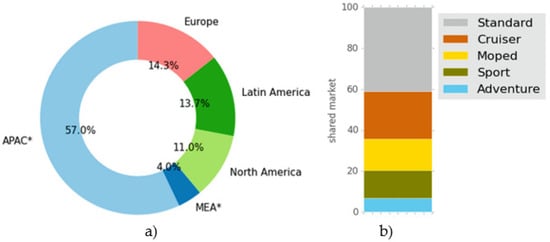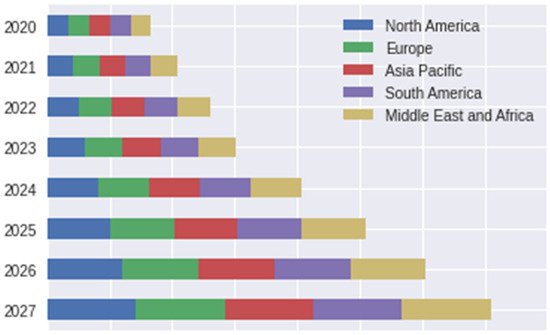In many cities, urbanization has led to a rapid increase in the demand for mobility. Most of this new demand has been satisfied by the individual private transport industry, within which motorcycles have an important share: around 30% of the vehicles in the world are motorcycles. Thus, the motorcycle market has experienced an upward trend, especially in developing countries. That uncontrolled growth brings along mobility, accidents, and environment-related issues that concern policy-makers. Research trends regarding this matter evidence that greenhouse gas emissions, sustainability, environmental impact, and developing countries are the topics of greater interest for researchers. In addition, taking into account the needs of modern cities, sustainable modes of transport such as electric and shared mobility are compulsory as a priority on governments' agendas.
- motorcycle
- sustainability
- transport system
1. Introduction

2. Motorcycle Market

This entry is adapted from the peer-reviewed paper 10.3390/su131910813
References
- Weiss, M.; Dekker, P.; Moro, A.; Scholz, H.; Patel, M.K. On the electrification of road transportation—A review of the environmental, economic, and social performance of electric two-wheelers. Transp. Res. Part D Transp. Environ. 2015, 41, 348–366.
- Persistence Market Research. Global Market Study on Motorcycles: Standard Scooters to Remain Largest Product Type through 2026; Persistence Market Research: New York, NY, USA, 2018.
- FactMR. Motorcycle Market Forecast. Trend Analysis & Competition Tracking—Global Market Insights 2020 to 2030; FactMR: Dublin, Ireland, 2020.
- Eccarius, T.; Lu, C.-C. Powered two-wheelers for sustainable mobility: A review of consumer adoption of electric motorcycles. Int. J. Sustain. Transp. 2020, 14, 215–231.
- Markets and Markets. Electric Scooter and Motorcycle Market; Markets and Markets: Pune, India, 2021.
- McD Team. Global Motorcycles Market Grew up in Double Digit in October 2020; McD Team: Luxembourg, 2020.
- Data Bridge Market Research. Electric Motorcycles Market—Global Industry Trends and Forecast to 2027. Available online: https://www.databridgemarketresearch.com/reports/global-electric-motorcycles-market (accessed on 1 March 2021).
- Chang, H.-L.; Wu, S.-C. Exploring the vehicle dependence behind mode choice: Evidence of motorcycle dependence in Taipei. Transp. Res. Part A Policy Pract. 2008, 42, 307–320.
- Axsen, J.; Sovacool, B.K. The roles of users in electric, shared and automated mobility transitions. Transp. Res. Part D Transp. Environ. 2019, 71, 1–21.
- Jones, L.R.; Cherry, C.R.; Vu, T.A.; Nguyen, Q.N. The effect of incentives and technology on the adoption of electric motorcycles: A stated choice experiment in Vietnam. Transp. Res. Part A Policy Pract. 2013, 57, 1–11.
- Xavier, J. The Rise of Electric Two-Wheelers in China: Factors for their Success and Implications for the Future. Ph.D. Thesis, University of Califronia, Davis, CA, USA, 2007.
- Sovacool, B.K.; Abrahamse, W.; Zhang, L.; Ren, J. Pleasure or profit? Surveying the purchasing intentions of potential electric vehicle adopters in China. Transp. Res. Part A Policy Pract. 2019, 124, 69–81.
- Chen, H.-S.; Tsai, B.; Hsieh, C. The effects of perceived barriers on innovation resistance of hydrogen-electric motorcycles. Sustainability 2018, 10, 1933.
- Rahmanullah, E.S.; Nurjanah, S. Influence of Product Quality, Price and Supporting Infrasturcture to Perceived Value and Interest in Buying of Electric Motorcycle. MATEC Web Conf. 2018, 215, 02006.
- Huang, S.K.; Kuo, L.; Chou, K.L. The impacts of government policies on green utilization diffusion and social benefits—A case study of electric motorcycles in Taiwan. Energy Policy 2018, 119, 473–486.
- Chen, H.-S.; Tsai, B.-K.; Hsieh, C.-M. Determinants of Consumers’ Purchasing Intentions for the Hydrogen-Electric Motorcycle. Sustainability 2017, 9, 1447.
- Wu, J.H.; Wu, C.W.; Lee, C.T.; Lee, H.J. Green purchase intentions: An exploratory study of the Taiwanese electric motorcycle market. J. Bus. Res. 2015, 68, 829–833.
- Seebauer, S. Why early adopters engage in interpersonal diffusion of technological innovations: An empirical study on electric bicycles and electric scooters. Transp. Res. Part A Policy Pract. 2015, 78, 146–160.
- Chen, H.S. Applying Technology Acceptance Model to Explore the Adoption of Hydrogen-Electric Motorcycle in Taiwan. Appl. Mech. Mater. 2013, 459, 494–498.
- Peraphan, J.; Hermann, K.; Markus, M. The conundrum of the motorcycle in the mix of sustainable urban transport. Transp. Res. Procedia 2017, 25, 4869–4890.
- Leung, A.; Burke, M.; Perl, A.; Cui, J. The peak oil and oil vulnerability discourse in urban transport policy: A comparative discourse analysis of Hong Kong and Brisbane. Transp. Policy 2018, 65, 5–18.
- International Energy Agency—IEA Tracking Transport 2020. Available online: https://www.iea.org/reports/tracking-transport-2020 (accessed on 1 July 2021).
- Bakker, S. Electric Two-Wheelers, Sustainable Mobility and the City. In Sustainable Cities: Authenticity, Ambition and Dream; IntechOpen: London, UK, 2019.
- Cordellieri, P.; Sdoia, S.; Ferlazzo, F.; Sgalla, R.; Giannini, A.M. Driving attitudes, behaviours, risk perception and risk concern among young student car-drivers, motorcyclists and pedestrians in various EU countries. Transp. Res. Part F Traffic Psychol. Behav. 2019, 65, 56–67.
- Silla, A.; Leden, L.; Rämä, P.; Scholliers, J.; van Noort, M.; Morris, A.; Hancox, G.; Bell, D. A headway to improve PTW rider safety within the EU through three types of ITS. Eur. Transp. Res. Rev. 2018, 10, 18.
- Taefi, T.T.; Kreutzfeldt, J.; Held, T.; Fink, A. Strategies to increase the profitability of electric vehicles in urban freight transport. Green Energy Technol. 2015, 203, 367–388.
- Biral, F.; Bosetti, P.; Lot, R. Experimental evaluation of a system for assisting motorcyclists to safely ride road bends. Eur. Transp. Res. Rev. 2014, 6, 411–423.
- Cheng, A.S.K.; Liu, K.P.Y.; Tulliani, N. Relationship Between Driving-violation Behaviours and Risk Perception in Motorcycle Accidents. Hong Kong J. Occup. Ther. 2015, 25, 32–38.
- Hidalgo-Fuentes, S.; Sospedra-Baeza, M.J. Gender and age distribution of motorcycle crashes in Spain. Int. J. Inj. Contr. Saf. Promot. 2019, 26, 108–114.
- Jou, R.C.; Yeh, T.H.; Chen, R.S. Risk factors in motorcyclist fatalities in Taiwan. Traffic Inj. Prev. 2012, 13, 155–162.
- Manan, M.; Varhelyi, A. Motorcycle fatalities in Malaysia. IATSS Res. 2012, 36, 30–39.
- Ospina-Mateus, H.; Quintana Jiménez, L.A.; Lopez-Valdes, F.J.; Salas-Navarro, K. Bibliometric analysis in motorcycle accident research: A global overview. Scientometrics 2019, 121, 793–815.
- Hsieh, P.Y.; Chang, L.F.W.; Yu, T.Y.; Wu, K.C. Evaluation of mitigation effects on air pollutants for electric scooters in Taiwan with the energy flow analysis and system dynamics approach. IOP Conf. Ser. Earth Environ. Sci. 2018, 191, 012136.
- Trappey, A.J.C.; Trappey, C.; Hsiao, C.T.; Ou, J.J.R.; Li, S.J.; Chen, K.W.P. An evaluation model for low carbon island policy: The case of Taiwan’s green transportation policy. Energy Policy 2012, 45, 510–515.
- Cheng, Y.-H.; Chang, Y.-H.; Lu, I.J. Urban transportation energy and carbon dioxide emission reduction strategies. Appl. Energy 2015, 157, 953–973.
- Routledge. Mapping Urbanities: Morphologies, Flows, Possibilities; Dovey, K., Pafka, E., Mirjana, R., Eds.; Taylor & Francis: New York, NY, USA, 2018; ISBN 978-1-138-23360-7.
- Thanh Truong, T.M.; Ngoc, A.M. Parking behavior and the possible impacts on travel alternatives in motorcycle-dominated cities. Transp. Res. Procedia 2020, 48, 3469–3485.
- Yang, W.-L.; Chen, L. A System Dynamics Approach To Evaluate The Impact Of Traffic Management Policy To Urban Air Quality. WIT Trans. Ecol. Environ. 2000, 42, 341–351.
- Bocken, N.; Jonca, A.; Södergren, K.; Palm, J. Emergence of Carsharing Business Models and Sustainability Impacts in Swedish Cities. Sustainability 2020, 12, 1594.
- Ampudia-Renuncio, M.; Guirao, B.; Molina-Sanchez, R.; Bragança, L. Electric Free-Floating Carsharing for Sustainable Cities: Characterization of Frequent Trip Profiles Using Acquired Rental Data. Sustainability 2020, 12, 1248.
- Ampudia-Renuncio, M.; Guirao, B.; Molina-Sanchez, R. The impact of free-floating carsharing on sustainable cities: Analysis of first experiences in Madrid with the university campus. Sustain. Cities Soc. 2018, 43, 462–475.
- Wielinski, G.; Trépanier, M.; Morency, C. Carsharing Versus Bikesharing: Comparing Mobility Behaviors. Transp. Res. Rec. 2017, 2650, 112–122.
